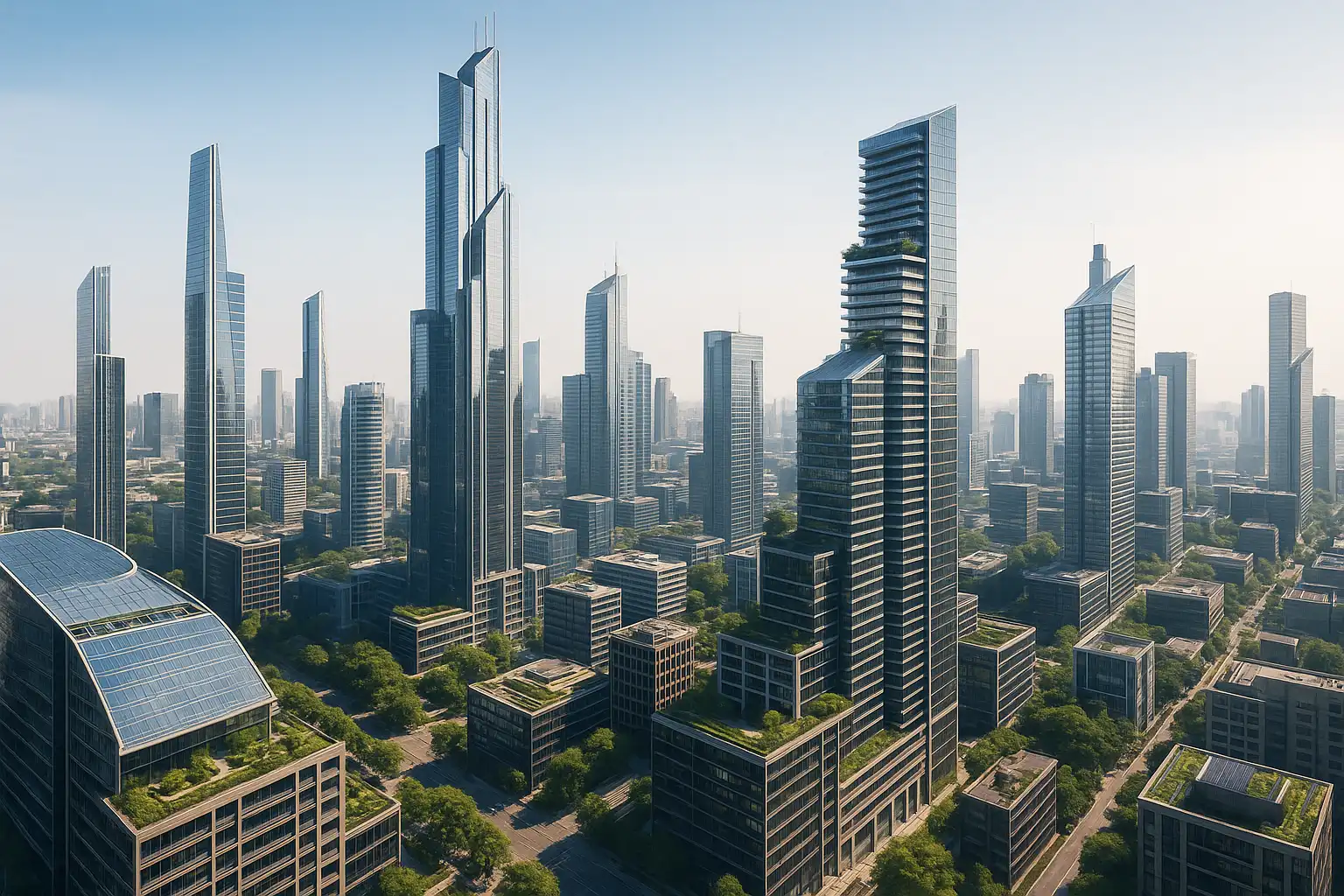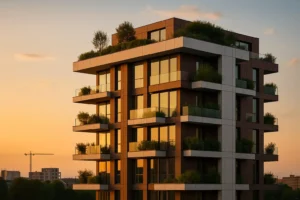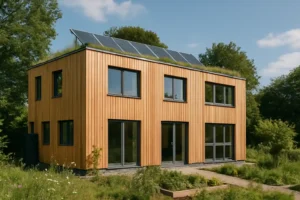
Modern Architectural Trends Transforming Urban Landscapes in 2025
Introduction
The skyline of our cities is evolving faster than ever before. In 2025, architecture is no longer just about building structures; it’s about shaping experiences, integrating technology, and designing for sustainability. Urban landscapes are becoming living, breathing entities that reflect the needs of modern society. Architects are embracing cutting-edge materials, smart technologies, and innovative design principles that prioritize both aesthetic appeal and functional efficiency. From eco-friendly skyscrapers to multi-use complexes, the modern cityscape is a testament to human ingenuity. This article explores the top architectural trends transforming urban landscapes today and why they matter for both communities and investors.
1. Sustainable and Green Architecture
Sustainability has become the cornerstone of modern architecture. Cities are grappling with climate change, overpopulation, and environmental degradation. To address these challenges, architects are designing buildings that minimize ecological impact. Green roofs, vertical gardens, energy-efficient materials, and water recycling systems are becoming standard features.
Key Elements:
- Green Roofs & Walls: Improve insulation, reduce heat islands, and support biodiversity.
- Energy-Efficient Materials: Solar panels, double-glazed windows, and low-emission concrete.
- Water Management Systems: Rainwater harvesting and greywater recycling.
For urban planners, sustainable architecture is more than a trend—it’s an obligation. Buildings now serve dual purposes: housing or office functions while also actively reducing environmental footprints.
2. Smart and Connected Buildings
Technology is reshaping how we interact with spaces. Smart buildings equipped with sensors, AI, and IoT devices optimize energy use, improve security, and enhance occupant comfort.
Key Features:
- Automated lighting, HVAC, and security systems.
- Real-time energy consumption monitoring.
- Integration with city-wide smart grids.
These innovations allow urban centers to operate more efficiently while providing residents with healthier, more responsive environments. Smart architecture not only improves convenience but also reduces operational costs for property owners.
3. Mixed-Use Developments
Urban space is limited, so the focus is shifting to mixed-use developments that combine residential, commercial, and recreational spaces in a single complex. This trend fosters vibrant communities and reduces commute times.
Advantages:
- Enhances social interaction and community engagement.
- Promotes walkability and reduces urban congestion.
- Encourages efficient land use and investment returns.
Architects are now designing multifunctional towers, urban plazas, and integrated public spaces that redefine city living. Mixed-use projects balance private and public needs while increasing property value.
4. Biophilic Design
Biophilic design emphasizes connecting humans with nature. In 2025, this approach is gaining momentum as urban populations seek wellness and mental well-being amidst concrete jungles.
Key Principles:
- Maximizing natural light and ventilation.
- Indoor gardens and water features.
- Organic forms and natural textures in interior and exterior design.
Studies show that biophilic spaces reduce stress, improve productivity, and enhance overall quality of life. Incorporating natural elements into urban architecture is now a critical design strategy.
5. Adaptive and Flexible Spaces
Urban living demands flexibility. Buildings are now being designed to adapt to changing needs—residential units that can be reconfigured, office spaces that transform into co-working hubs, and public areas that accommodate multiple events.
Examples:
- Movable partitions and modular walls.
- Convertible rooftops and terraces.
- Shared community amenities that adjust to population changes.
Adaptive design ensures longevity and cost-effectiveness, allowing buildings to remain functional and relevant for decades.
6. Minimalist and Functional Design
Minimalism is not just about aesthetics; it’s about efficiency. Architects are prioritizing clean lines, uncluttered spaces, and purposeful layouts. Every element is intentional, enhancing both form and function.
Benefits:
- Reduces construction costs and maintenance.
- Encourages better spatial planning.
- Enhances the overall visual appeal of urban landscapes.
Functional, minimalist designs are particularly effective in densely populated cities where space optimization is critical.
7. Iconic and Statement Architecture
Cities want landmarks, and architects are delivering iconic structures that define skylines. Bold shapes, daring angles, and unique façades are being used to create unforgettable cityscapes.
Examples:
- Twisting skyscrapers with innovative geometry.
- Cultural centers with avant-garde designs.
- Bridges, towers, and public buildings that double as urban art.
Iconic architecture attracts tourism, media attention, and investment, making cities globally recognizable and culturally significant.
8. Integration of AR and VR in Design
Virtual and augmented reality tools are revolutionizing how architects and clients visualize projects. By 2025, AR and VR are standard in design presentations, enabling stakeholders to experience buildings before construction.
Advantages:
- Helps clients make informed design decisions.
- Minimizes errors during construction.
- Enhances collaboration between designers, engineers, and contractors.
The ability to walk through a digital twin of a building streamlines approval processes and ensures design intent is realized.
9. Resilient and Disaster-Ready Structures
Climate change has made resilience a design priority. Architects are now factoring in natural disasters, extreme weather, and long-term durability.
Key Measures:
- Earthquake-resistant frameworks.
- Flood defenses and elevated foundations.
- Wind-resistant façades and reinforced materials.
Resilient design protects lives, reduces insurance costs, and contributes to sustainable urban growth.
10. Use of Advanced Materials
Innovative materials such as self-healing concrete, transparent aluminum, and carbon-fiber composites are transforming construction. These materials are lighter, stronger, and more durable than traditional options.
Applications:
- Facades that clean themselves or change color with temperature.
- Lightweight yet strong structural elements for skyscrapers.
- Sustainable, recycled, and locally sourced materials.
Advanced materials allow architects to push boundaries and create futuristic urban landscapes that were once considered impossible.
Conclusion
Modern architectural trends are not just shaping buildings—they’re shaping cities, communities, and lifestyles. From sustainable innovations to smart technology, adaptive spaces, and iconic designs, the urban landscape of 2025 reflects the ingenuity of contemporary architecture. Embracing these trends allows cities to thrive economically, socially, and environmentally. Whether you are a developer, investor, or homeowner, understanding and integrating these trends ensures your projects remain relevant, efficient, and visually stunning.
For expertly crafted architectural solutions that bring your vision to life, reach out to BATIMOI BTP today. Let our team of experienced architects and designers guide your project from concept to completion with precision, creativity, and sustainability in mind.


